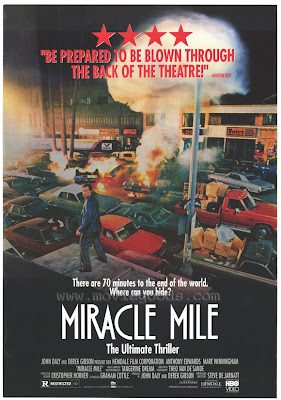
Whatever happened to Steve DeJarnatt?
His second film, 1989’s "Miracle Mile" - his follow-up to his first film, "Cherry 2000" of 1987 - is a very special movie, drop-dead beautiful and with an intense sense of style that's matched by its excellent, legendary script.
DeJarnatt's original screenplay was written way back in 1978 and chosen in 1983 by American Film magazine as "one of the 10 best unmade scripts." Its originality and lack of compromise frightened Hollywood, I suppose, and so DeJarnatt spent the next 10 years working on other people's movies.
He made his directorial debut with the much-touted premiere episode of the "Alfred Hitchcock Presents" revival - "The Man From the South," starring John Huston, Melanie Griffith, Steven Bauer and Tippi Hedren - and then made his big-screen bow directing Griffith in "Cherry 2000" (which was never released theatrically by Orion).
In the meantime, he persisted and finally persuaded John Daly of Hemdale to let him make "Miracle Mile." And his small movie is just about perfect.
DeJarnatt's plot is a boy-meets-girl romance that's threatened to be aborted by a nuclear catastrophe. And the situation that cleverly sets it all in motion is what happens when the wrong person answers a phone.
Harry Washello (Anthony Edwards) is a traveling jazz musician (he plays the trombone) - single and shy - who meets the woman of his dreams in a natural history museum near the La Brea Tar Pits in L.A.

Julie Peters (Mare Winningham) is a waitress who works the night shift at Johnnie's Coffee Shop, a 24-hour diner in the Park Brea district. (The movie's title comes from the famous strip along Los Angeles' Wilshire Boulevard that connects the preserved fossils of the tar pits to the area's contemporary skyscrapers.)
Anyway, they make plans for a big date - at one in the morning, after Julie gets off from work. Well, Harry gets there three hours late - Julie, brokenhearted, is long gone, having headed home to sleep off her depression, with the help of some pills. How Harry manages to stand her up provides a good example of the movie's details and ricocheting quality: He's on the balcony of his apartment, smoking, when he flicks away his butt. A pigeon picks it up and takes it to the electrical wire where it's nesting. A fire breaks out, blacking out Harry's apartment and thereby cutting off his alarm clock.
So he's three hours late.
Harry is about to call Julie on the pay phone outside Johnnie's when ... it rings: The voice on the other end is calling from a North Dakota missile silo. He's hysterical and has obviously misdialed. He wanted to talk to his father, to apologize for something and to warn him that the base's warhead has been locked into countdown: "We shoot our wad in 50 minutes!" Then there's the sound of a gunshot and another voice comes on: "Forget everything you just heard."
In a scene reminiscent of the one in Hitchcock's "The Birds," Harry tries to tell Johnnie's motley assortment of night crawlers (a transvestite, two truck drivers and a yuppie stockbroker named Landa, who is speed-reading "Gravity's Rainbow") what's about to happen. Is it real or a sick joke?
Landa (Denise Crosby, granddaughter of Bing), who happens to know the right people, makes a phone call and learns that a state of readiness is in the works. Incredibly, she lines up a helicopter to transport everyone there - and some others (including "Tom and Jane") - to the South Pole, where the air apparently will be clear of radioactivity. But if he's only got a little time left, Harry wants to spend it with Julie and embarks on a romantic chase to find her.
When he does, DeJarnatt comes up with another zany touch: Julie is still in a deep sleep, zonked out, and so Harry just plops her in a shopping cart and races through a deserted, very noir-ish L.A. in the dead of night.

"Miracle Mile," with its ripe camera work (courtesy of Holland's Theo Van de Sande), is over-the-top filmmaking, all twisty and quirky and bizarrely funny - like a fever dream. And visually, it's like a love poem to a very special time - the hours between darkness and dawn, as neon signs blink on and off and the morning light gradually seeps through buildings and alleys.
The film, released briefly on VHS, has gone full circle and is now forgotten or only half-remembered. As the line from Ernest Dowson's poem goes (I'm paraphrasing), it emerged from a misty dream, for a while, and then closed, within a dream.
Try finding it.
Oh, yes, to answer my initial question, Steve DeJarnatt eventually segued into television. He never made another feature after "Miracle Mile."
Cinema Obscura is a recurring feature of The Passionate Moviegoer, devoted to those films that have been largely forgotten. Suggestions welcome.
(Artwork: Poster art for "Miracle Mile"; Anthony Edwards in a scene from the film, and the real Miracle Mile, the strip along Los Angeles' Wilshire Boulevard that connects the preserved fossils of the tar pits to the area's contemporary skyscrapers)
No comments:
Post a Comment